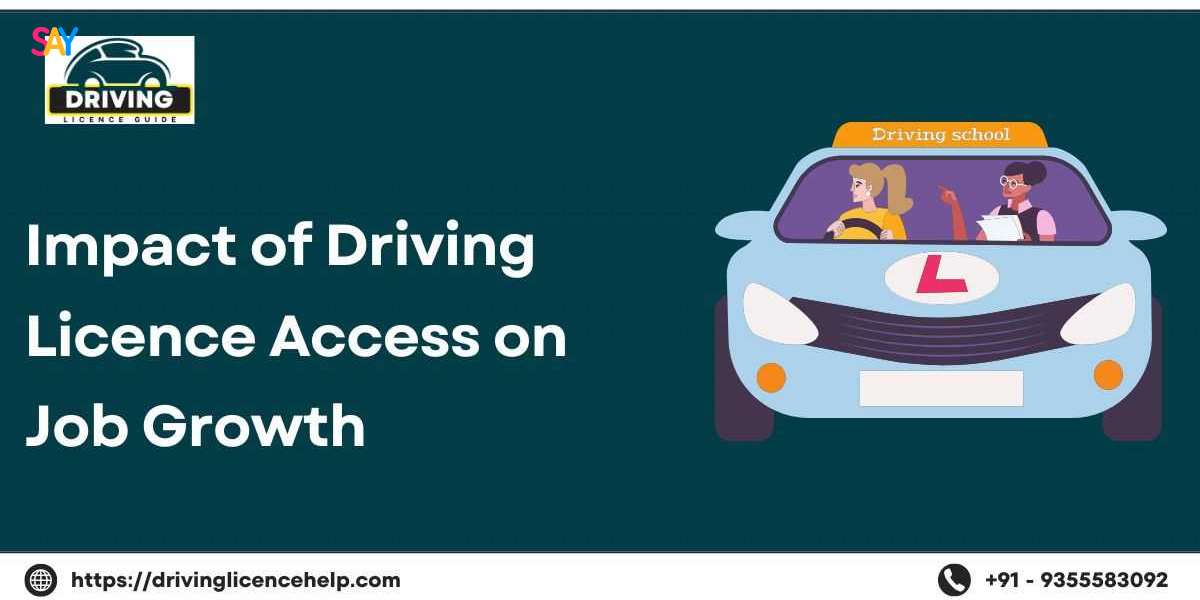A driving licence is more than just a permit to operate a vehicle—it’s a powerful enabler of economic opportunity, social mobility, and regional development. Access to a driving licence often correlates with an individual's ability to secure and retain employment, especially in industries reliant on transportation or shift-based roles. In both developed and developing economies, access to driving licences has a ripple effect on job creation, workforce participation, and overall productivity.
This article explores the multifaceted relationship between driving licence access and job growth. From reducing unemployment to enhancing women’s workforce participation and supporting gig economy workers, the impact of driving licence access reaches far beyond the individual. It is a critical, yet often overlooked, factor in shaping national economic trajectories.
Driving Licence as a Tool for Employment Access
1.1 Breaking Geographical Barriers
Many job opportunities are located far from city centers or in regions poorly served by public transportation. This spatial mismatch creates barriers for job seekers without private transportation. Access to a driving licence helps bridge this gap by enabling people to reach workplaces that are otherwise inaccessible.
1.2 Enabling Shift Work and Flexible Hours
A significant portion of the labor market operates outside of traditional 9-to-5 hours. Workers in healthcare, manufacturing, security, and logistics often work night shifts or rotating schedules. Public transportation is often unavailable during these hours, making a driving licence a prerequisite for employment in such sectors.
1.3 Boosting Rural Employment
In rural areas, where public transportation infrastructure is often lacking, a driving licence can be the difference between employment and chronic underemployment. With a licence, rural residents gain access to a wider range of jobs, both within and outside their immediate communities.
Driving Licence Access and Youth Employment
2.1 Transitioning from Education to Employment
Young people entering the job market often face multiple hurdles, including limited experience and mobility. Driving licence access helps facilitate this transition by opening up entry-level jobs that require commuting or involve driving, such as delivery roles, fieldwork, or sales.
2.2 Vocational Training and Licensing Synergy
Programs that integrate vocational training with driver education see significantly higher employment outcomes. For example, logistics and transport training programs that include licensing as part of the curriculum prepare participants for immediate job entry upon certification.
The Gig Economy and Transport-Based Jobs
3.1 Fueling the Gig Economy
Ride-sharing, food delivery, and logistics platforms have revolutionized the way people work. These platforms rely on workers having valid driving licences. As such, expanding access to licences directly contributes to the growth of the gig economy, offering flexible employment options to millions.
3.2 Driving as an Entry Point to Entrepreneurship
Driving also acts as a gateway to self-employment. Whether it’s driving a taxi, running a delivery service, or offering mobile repair services, the act of driving allows individuals to become their bosses. A driving licence is the foundation of this entrepreneurial activity.
Economic Impact on the Local and National Scales
4.1 Enhancing Workforce Participation Rates
Wider access to driving licences increases the employable pool. This is especially important in economies with ageing populations or those attempting to integrate underrepresented groups into the workforce. With a licence, these individuals can take jobs previously out of reach.
4.2 Job Multipliers in Transport and Automotive Sectors
Access to driving licences creates demand for vehicles, maintenance, insurance, fuel, and road infrastructure. This, in turn, drives employment in automotive manufacturing, sales, and support services, creating a job multiplier effect that benefits multiple sectors.
Women’s Empowerment and Inclusive Growth
5.1 Empowering Women Through Mobility
Globally, women are disproportionately affected by mobility constraints. Cultural norms, safety concerns, and lack of access to private transportation limit their employment options. A driving licence provides autonomy, expands safe commuting options, and boosts economic independence.
5.2 Increasing Female Labor Force Participation
Driving licence access for women has been directly linked to increased participation in the workforce. When women can drive, they are better able to balance domestic responsibilities with employment, take up part-time or gig jobs, and engage in entrepreneurial ventures.
Policy Initiatives and Global Best Practices
6.1 Government-Led Licensing Drives
Countries like India, Kenya, and Brazil have implemented government-backed programs to simplify licence access for underprivileged populations. These initiatives often involve mobile testing units, online applications, and reduced fees.
6.2 Integrating Licensing into Workforce Development
Several nations now include driving licence training as part of national employment or skills development programs. This integration ensures that job readiness includes both technical and mobility components, improving the effectiveness of such initiatives.
6.3 Collaboration with the Private Sector
Companies are increasingly investing in driving licence access for their potential employees. Logistics companies, for instance, often sponsor driver training programs to build a pipeline of qualified candidates, ensuring business continuity and growth.
Recommendations for Maximizing Job Growth Through Licence Access
7.1 Reduce Financial Barriers
Implement subsidies, scholarships, or payment plans for licence training and tests to help low-income individuals.
7.2 Expand Public-Private Partnerships
Encourage collaboration between driving schools, employers, and government agencies to offer employment-linked training.
7.3 Integrate with Job Readiness Programs
Driving licence training should be a standard component of workforce development programs, especially in logistics, construction, and retail.
7.4 Gender-Specific Policies
Create safe, inclusive environments for women learning to drive, and offer incentives to encourage female participation in licence programs.
Note:- How to Apply for a Driving Licence in India- Online/Offline
Conclusion
Access to a driving licence has a profound impact on job growth. It enhances individual employment prospects, strengthens economies, and fosters social equity. Governments, businesses, and civil society must work together to remove barriers to licence access and integrate mobility into workforce development strategies. In doing so, they will not only boost job growth but also ensure that the benefits of economic opportunity reach all corners of society.




